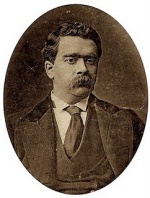Help us get to over 8,767 articles in 2025.
If you know of a magician not listed in MagicPedia, start a New Biography for them. Contact us at magicpediahelp@gmail.com
Dr. Lynn
| Dr. Lynn | |
 | |
| Born | Hugh Washington Simmons October 17, 1831 England or Australia |
|---|---|
| Died | 1899 |
Dr. Lynn (b.1831-d.1899), born Hugh Washington Simmons in either England or Australia, toured many countries including the Orient and the United States. It's possible that Houdini became fascinated with magic as a young boy after seeing Dr. Lynn perform in his home town.
Biography
Lynn had left the British navy in 1861 to begin a career as a magician in Australia, where he performed as Washington Simmons and Washington Blythe. Afterward, he was billing himself as "Professor Simmons, the Great Basilicothaumaturgist" in the Orient, Europe and US. Dr. Lynn reached San Francisco from Japan in December, 1863.
In San Francisco he meets Artemus Ward and E. P. Hingston. Hingston, in his book, "The genial showman, reminiscences of the life of 'Artemus Ward'" he talks about helping an unnamed magician, which happens to be Dr. Lynn.[1]
In the book "Travels and Adventures of Dr. Lynn", it tells about a practical joke, which was assisted by Hinston, played upon Brigham Young, during a visit to Salt Lake City, Utah, in 1864.
Dr. Lynn, then still known as Simmons, dispatched a message to Brigham Young that he had to see him on an urgent matter. When Young ushered the magician in, Simmons claimed that the new patent leather boots on the prophet's feet were a pair he had left behind during a visit the night before. The prophet disagreed. His boots had been custom made and he said there was not another pair like them in Utah. The magician countered that his boots had his name in blood-red letters on the bottoms. Young removed one boot and turned it sole upwards noticing "SIMMONS" in bright red! Yanking off the remaining boot another fiery red "SIMMONS" blazed up from its sole. When the prophet regained his speech he offered the wizard a high post and his daughters in marriage if he would become a Mormon. Simmons said later that he was tempted, but he refused the generous offer.
While Simmons and Brigham Young were talking on the evening before the trick, it was Hingston who dipped a pen in red ink, approached the prophet from behind during a moment when he had his knee resting on a chair and scrawled the wizard's name on the sole. After they left, Hingston, in great glee, confesssed to his prank. Simmons got Hingston to promise to keep the matter secret and arranged to perform the trick the next day confident that the prophet would not notice the writing until his attention was called to it.
After Simmons moved on toward the east, Young must have reconsidered the events as it is said that the prophet went to the tabernacle and publicly thanked the Lord that the devil had left town.
According to The Encyclopedic Dictionary of Magic by Bart Whaley, Dr. Lynn was the first to perform the Japanese Butterfly Trick in the west in 1864. He had claimed that he had seen the trick while traveling in Japan in 1863. Some time in the 1870s, Lynn created a puppet effect called Living Marionettes. using what is known as Black Art.
The decapitation act (involving the apparent severance of the left arm, left leg or head of a man was introduced by Dr. Lynn in 1874 under the title of "Palingenesia". Other effects he presented were a suspension, a Flower Growth, the Basket Trick, Rope Ties, Spirit Writing and Spirit Manifestations, and his own version of the Maskelyne Trunk Trick.
He retired in April 1895. It is recorded in the Magic Wand Annals that Dr. Lynn fell on hard times and, in 1896, benefit performances were held for him.
His often repeated "That's how it's done" during his shows became popular catch phrase in England.
His son Walter Lynn (also an entertainer) reported his fathers passing in Mahatma Vol. 03 (1899). Dr. Lynn's son was also apparently involved in a lawsuit with Maskelyne over the trunk trick and won.
Several of the Houdini biographies name Dr. Lynn as the magician Houdini saw as a boy, although it's more likely he saw a Dr. Lynn imitator.[2] Later in life, Houdini purchased props from Dr. Lynn's son, J. Wellesley Lynn, who was also a conjurer and ventriloquist. His son became known as a magician, specializing in adaptations of his fathers repertoire but later finding his own feet as a card magician.[3]
Books
- The Adventures of the Strange Man, With a Supplement showing "How It's Done"(1873)
References
- The Illustrated History of Magic By Milbourne Christopher (1973)
- Victorian Magic by Geoffrey Lamb (1976)
- Magicol No. 74 (February 1985), page 14.
- Who Inspired Houdini?